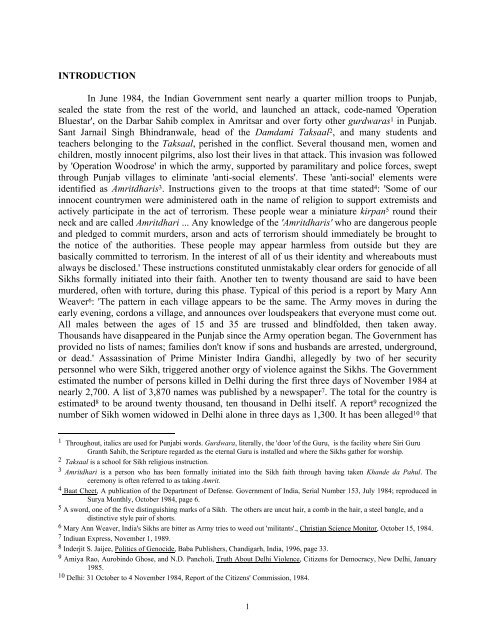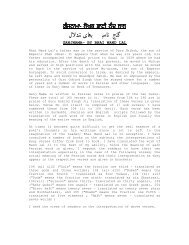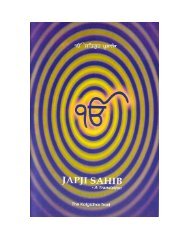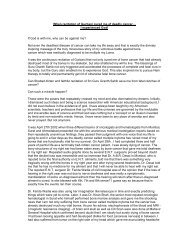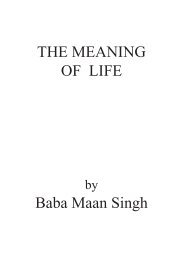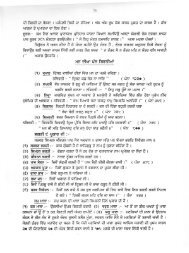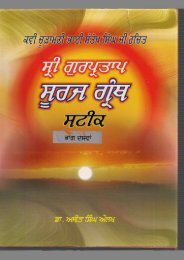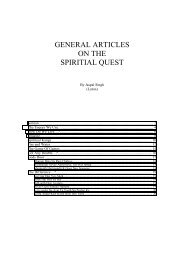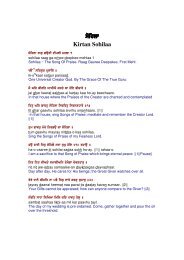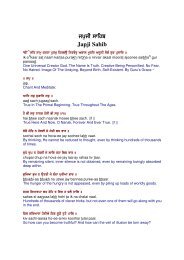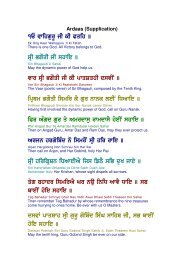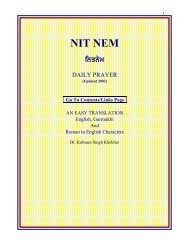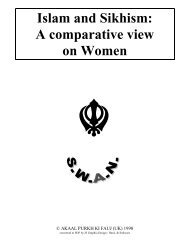Sant Jarnail Singh Bhindranwale - Sikh Missionary Society (UK)
Sant Jarnail Singh Bhindranwale - Sikh Missionary Society (UK)
Sant Jarnail Singh Bhindranwale - Sikh Missionary Society (UK)
You also want an ePaper? Increase the reach of your titles
YUMPU automatically turns print PDFs into web optimized ePapers that Google loves.
INTRODUCTIONIn June 1984, the Indian Government sent nearly a quarter million troops to Punjab,sealed the state from the rest of the world, and launched an attack, code-named 'OperationBluestar', on the Darbar Sahib complex in Amritsar and over forty other gurdwaras 1 in Punjab.<strong>Sant</strong> <strong>Jarnail</strong> <strong>Singh</strong> <strong>Bhindranwale</strong>, head of the Damdami Taksaal 2 , and many students andteachers belonging to the Taksaal, perished in the conflict. Several thousand men, women andchildren, mostly innocent pilgrims, also lost their lives in that attack. This invasion was followedby 'Operation Woodrose' in which the army, supported by paramilitary and police forces, sweptthrough Punjab villages to eliminate 'anti-social elements'. These 'anti-social' elements wereidentified as Amritdharis 3 . Instructions given to the troops at that time stated 4 : 'Some of ourinnocent countrymen were administered oath in the name of religion to support extremists andactively participate in the act of terrorism. These people wear a miniature kirpan 5 round theirneck and are called Amritdhari ... Any knowledge of the 'Amritdharis' who are dangerous peopleand pledged to commit murders, arson and acts of terrorism should immediately be brought tothe notice of the authorities. These people may appear harmless from outside but they arebasically committed to terrorism. In the interest of all of us their identity and whereabouts mustalways be disclosed.' These instructions constituted unmistakably clear orders for genocide of all<strong>Sikh</strong>s formally initiated into their faith. Another ten to twenty thousand are said to have beenmurdered, often with torture, during this phase. Typical of this period is a report by Mary AnnWeaver 6 : 'The pattern in each village appears to be the same. The Army moves in during theearly evening, cordons a village, and announces over loudspeakers that everyone must come out.All males between the ages of 15 and 35 are trussed and blindfolded, then taken away.Thousands have disappeared in the Punjab since the Army operation began. The Government hasprovided no lists of names; families don't know if sons and husbands are arrested, underground,or dead.' Assassination of Prime Minister Indira Gandhi, allegedly by two of her securitypersonnel who were <strong>Sikh</strong>, triggered another orgy of violence against the <strong>Sikh</strong>s. The Governmentestimated the number of persons killed in Delhi during the first three days of November 1984 atnearly 2,700. A list of 3,870 names was published by a newspaper 7 . The total for the country isestimated 8 to be around twenty thousand, ten thousand in Delhi itself. A report 9 recognized thenumber of <strong>Sikh</strong> women widowed in Delhi alone in three days as 1,300. It has been alleged 10 that1 Throughout, italics are used for Punjabi words. Gurdwara, literally, the 'door 'of the Guru, is the facility where Siri GuruGranth Sahib, the Scripture regarded as the eternal Guru is installed and where the <strong>Sikh</strong>s gather for worship.2 Taksaal is a school for <strong>Sikh</strong> religious instruction.3 Amritdhari is a person who has been formally initiated into the <strong>Sikh</strong> faith through having taken Khande da Pahul. Theceremony is often referred to as taking Amrit.4 Baat Cheet, A publication of the Department of Defense. Government of India, Serial Number 153, July 1984; reproduced inSurya Monthly, October 1984, page 6.5 A sword, one of the five distinguishing marks of a <strong>Sikh</strong>. The others are uncut hair, a comb in the hair, a steel bangle, and adistinctive style pair of shorts.6 Mary Ann Weaver, India's <strong>Sikh</strong>s are bitter as Army tries to weed out 'militants'., Christian Science Monitor, October 15, 1984.7 Indiuan Express, November 1, 1989.8 Inderjit S. Jaijee, Politics of Genocide, Baba Publishers, Chandigarh, India, 1996, page 33.9 Amiya Rao, Aurobindo Ghose, and N.D. Pancholi, Truth About Delhi Violence, Citizens for Democracy, New Delhi, January1985.10 Delhi: 31 October to 4 November 1984, Report of the Citizens' Commission, 1984.1


